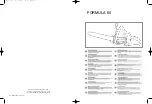
6
100642 - ChAiNSAw
iMPORTANT SAfETY iNSTRUCTiONS
Kickback Safety
wARNiNG
Kickback may occur when the nose or tip of the guide bar
touches an object, or when the wood closes in and pinches
the saw chain in the cut. In some cases, tip contact may cause
a lightening-fast reverse action, kicking the guide bar rapidly
back towards the operator. Pinching the saw chain along
the top of the guide bar may push the guide bar rapidly back
towards the operator. Either of these reactions may cause
a loss of control over the saw, which could result in serious
injury to the user. Contact with foreign objects within the wood
can also induce a loss of chain saw control.
Understanding Kickback
A basic understanding of kickback can help reduce or eliminate
the element of surprise and the chance of kickback-related injury.
Sudden surprise contributes to accidents.
–
Rotational Kickback
can happen when the upper tip of
the guide bar contacts an object while the chain is moving
(Fig. A). This can cause the chain to dig into the object and
momentarily stop moving. The guide bar is then kicked up and
back toward the operator in a lightning-fast reverse reaction.
–
Linear Kickback
can happen when the wood on either side
of a cut closes in and pinches the moving saw chain along
the top of the guide bar (Fig. B). This can cause the chain
to instantly stop. The chain force is then reversed, causing
the saw to move in the opposite direction, sending the saw
straight back toward the operator.
–
Pull-In
can happen when the moving chain on the bottom
of the guide bar hits a foreign object inside the wood. This
can cause the chain to suddenly stop. The saw is then pulled
forward and away from the operator, which could potentially
result in the loss of control of the saw.
Fig. A
Fig. B
Rotational
Kickback
Kickback
Danger Zone
Saw Chain
Direction
Linear
Kickback
Pinch
Figure A
Fig. A
Fig. B
Rotational
Kickback
Kickback
Danger Zone
Saw Chain
Direction
Linear
Kickback
Pinch
Figure B
Kickback Safety Precautions
Take the following steps to reduce the chance of accident or
injury:
–
Do not rely exclusively upon the safety devices built into the
chainsaw.
–
Do not cut above shoulder height.
–
Do not over reach. Always keep proper footing and balance.
Take extra care when working on steep slopes or inclines.
–
Do not make cuts with the tip of the guide bar.
–
Make sure the area of operation is free from obstructions.
Do not let the tip of the guide bar contact any object, such as a
log, branch, the ground or other obstruction.
–
Always inspect the wood before cutting. Foreign objects could
damage the chainsaw or cause serious personal injury. Never
cut through nails, metal rods, railroad ties or pallets.
–
Do not operate the chainsaw with one hand! Serious injury to
the operator, helpers or bystanders may result from one-
handed operation. This chainsaw is intended for two-handed
use. Always grip the chainsaw firmly with both hands when
the chainsaw is running. Hold the front handle with the left
hand and the rear handle with the right hand. Firmly encircle
the handles with the thumbs and fingers. Do not let go. A firm
grip will help maintain control of the chainsaw and reduce the
chance of kickback.
–
Stand slightly to the left of the chainsaw to avoid being in the
direct line of the saw chain.
–
Never start the saw when the guide bar is inside an existing
cut. Be extremely careful when re-entering a cut.
–
Always begin a cut with the chainsaw running at full speed.
Fully squeeze the throttle control and maintain a steady cutting
speed. Slower speeds increase the chance of kickback.
–
Keep the saw housing pressed firmly against the wood.
–
Do not cut more than one log or branch at a time.
–
Do not twist the chainsaw when removing the guide bar from
a cut.
–
Watch out for shifting objects (logs, branches, etc.) that might
pinch or fall onto the saw chain during operation.







































